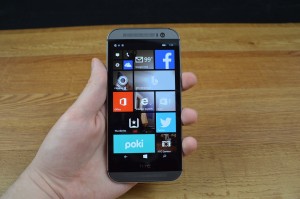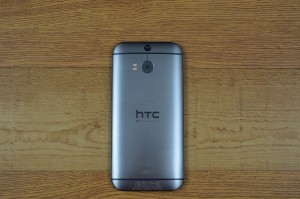Windows Phone is defined by its failures. So entrenched is the mobile duopoly of Google and Apple that the only way to talk about Microsoft’s fledgling platform is by noting what it lacks in comparison to Android and iOS. Four years ago Microsoft poured resources into a race that was already half-finished, decided to try beating its rivals at their own game, and has found itself in a constant state of catch-up ever since. Most people don’t want it, justifiably.
The result is an OS that’s become perfectly usable, but has never been the best at anything other than pulling you into Microsoft’s ecosystem. It’s neither as fluid as iOS nor as functional as Android, and its app catalog still trails them both. And its device selection has long lacked parity, having been almost entirely dominated by Lumias for years now.
It’s that last shortcoming that the phones like the HTC One (M8) for Windows can help address. Released earlier this year, it’s a device that doesn’t do much to dissuade the notion that Windows Phone is a second-class citizen. On the outside, it’s almost entirely identical to the phone Android users had been privy to for months prior. The metal body, the big display, the weird cameras – all of it is back again. However, because the One (M8) is such a quality machine on its own, this is still mostly a very good thing.
And even if you can gather all of its changes from its name alone (and you can), the One (M8) for Windows is important, if only because it gives Microsoft something close to a level playing field on which it can compete with Android. In doing that, though, it also highlights some of the failures that have put Microsoft is in its current position in the first place. Let’s take a closer look at the device, which is available now for Verizon, AT&T and T-Mobile.
The Same Great Design
We’ve extolled the virtues of the One (M8)’s hardware a few times before, so there isn’t much more to say other than it’s still a fantastic feeling, supremely well-made phone. Its all-aluminum build is thin, cool, smooth and sturdy, and still has enough curve to the back to slide comfortably into your palms. Its look is consistent and professional, with that fine coat of brushed metal extending through its chamfered edges and clean, straight lines all the way around. Its buttons are still solid, its speakers are still the best in their class, and its 5-inch 1080p display is still sizable and vibrant. Simply put, this is one of the few designs that justifies that $650 price tag. It is a gorgeous intersection of aesthetic and accessibility.
That said, the same problems are also present. The power button is still placed awkwardly on the phone’s top, so even large-handed users will have to really stretch to reach it. The metal feels slippery compared to cheaper materials. The Verizon and Windows Phone logos on the back of our test unit are a tad distracting. There’s also a fair bit of wasted space around the screen, especially through its bottom bezel
These are all minor gripes in the long run, though. The design does nothing different this go round, but because Microsoft still lacks an obviously high-end flagship that it can parade alongside Apple’s iPhone 6 and Google’s Nexus 6, this version of One (M8) is the go-to choice for Windows Phone users seeking premium build quality.
But That Camera
HTC’s refusal to tinker with the One (M8)’s hardware is mostly a good thing, but it also means that its iffy main camera has reared its mediocre head again. As a reminder, it’s a 4-megapixel unit with HTC’s “UltraPixel” tech, which uses fewer pixels than you’d usually find on a flagship but blows them up in an effort to capture more light and take better shots in the dark. Just above the rear shooter is a “Duo Camera” sensor, which can be used to add depth of field and 3D-style effects to your photos after they’ve been taken.
HTC has already started to move away from the UltraPixel project in the months since the One (M8) launched, and with good reason: This camera just isn’t very good. In fact, it seems to have taken a slight step back with the OS switch. The larger pixels tend to let in too much light in daytime settings, often washing out colors enough to look less accurate than we remember. It also has a hard time staying totally in focus (there’s no OIS here), and it isn’t able to take in the amount of detail we’ve come to expect from today’s flagship cameras. Nighttime shots are better, predictably, but still could stand to be sharper.
All of this can be used through the “HTC Camera” app, which almost entirely recreates the camera UI from the original One (M8). (The default WP camera app is still there too, of course.) It looks out of place with the rest of the Windows Phone aesthetic, but it’s still useful, tucking away a bunch of special editing features without cramping up the viewfinder. It shoots fast and is easy to pick up, though it is missing the “Zoe” clip-making tool that’s become popular on Android, unfortunately.
The aforementioned Duo Camera contributes to those effects with tricks like “UFocus,” which allows you to add a bokeh effect and change a photo’s point of focus, and “3D Dimension Plus,” which lets you tilt around the objects in a shot through a 3D-esque perspective. The Duo sensor still doesn’t have much of a purpose outside of letting you screw around with stuff, but it’s a fun diversion either way.
Things like this help make the camera more tolerable for a casual pic every now and then, but that’s about as far as it can reliably go. Its shortcomings look worse than usual now that it’s in the library of Windows Phones, where Nokia (or Microsoft, now) has consistently produced excellent cameras with its Lumia devices. It’s worth noting that the 5-megapixel unit on the front of the One (M8) for Windows is still one of the sharper cams around, but if you’d like more than selfies from your Windows Phone, stick with a Lumia.
The post HTC One (M8) for Windows Review: New Phone, Same Story appeared first on Brighthand.com.



